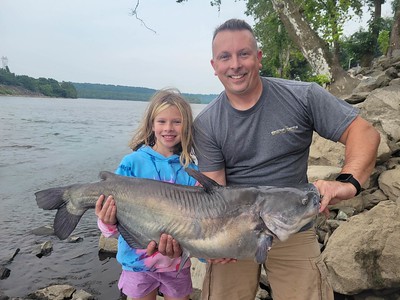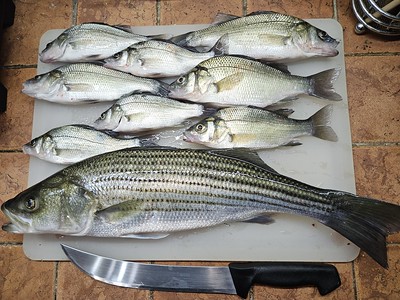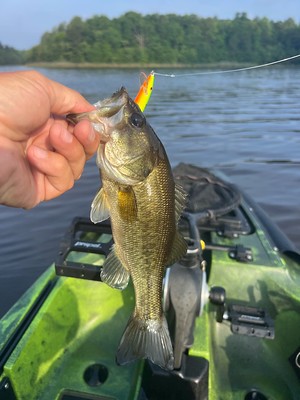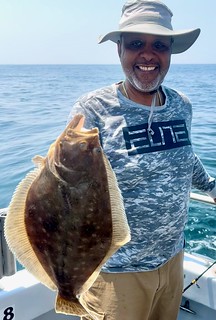Maryland Fishing Report – June 21, 2023

David Springham and daughter Phoebe went fishing together after dad got off from work, and they caught this blue catfish near the Conowingo Dam pool. Photo courtesy of David Springham
Often it is those small moments spent together with our loved ones that turn out to be special and long remembered. Fishing together definitely provides those moments, especially with our youngest anglers.
July 4 is just around the corner and with it the last free fishing day being offered in Maryland for 2023. Think about taking a friend, neighbor, or relative on a holiday fishing trip and introduce them to this wonderful pastime.
Forecast Summary: June 21 – June 27
A partly cloudy week is ahead with continued warm weather and a chance of rain most of the next week. Main Bay surface water temperatures are holding in the low 70s. Bay salinity is still above average. Some areas of low oxygen are present in bottom waters from Love Point down to Bloody Point, as well as in the Potomac River near Colonial Beach. Avoid fishing below 25 feet in these areas. However, there are still plenty of cool, well oxygenated areas in the Bay to pursue Maryland gamefish, including the main Bay on the western side from Tolchester north to the Susquehanna Flats, and the area from Gooses Reef south to the Virginia line.
Expect below average flows all week. There will be above average tidal currents through Saturday as a result of the June 18 new moon. Expect average water clarity in Maryland’s waters. To see the latest water clarity conditions, check Eyes on the Bay Satellite Maps.
As always, the best fishing areas could be further refined by intersecting them with underwater points, hard bottom, drop-offs, and large schools of baitfish.
For more detailed and up-to-date fishing conditions in your area of the Bay, be sure to check out Eyes on the Bay’s Click Before You Cast.
Upper Chesapeake Bay
Anglers are reporting good fishing for striped bass at the Conowingo Dam pool this week; flows at the dam are down so anglers are casting as close to the turbine discharge as possible. The best fishing success occurs in the early morning and evening hours while casting paddletails, jerkbaits, and poppers. The fishing for striped bass at the edges of the Susquehanna Flats has slowed down this week, most likely due to diminished cool water flows from the Conowingo Dam.
Recreational boaters and anglers are advised to watch out for a prohibited entry area near Aberdeen Proving Ground. Mariners are advised that the Aberdeen Test Center will be conducting live fire exercises and operational testing of various watercraft, through October 1, 2023. The operation area includes the water near Bear Point, proceeding southeast towards Aberdeen’s K Buoy, southward along the restricted water boundary to H Buoy, westward to the mouth of Delph Creek, and then returning to the Bear Point area. Watercraft will be escorted by Aberdeen’s patrol boats, which will also ensure the area is clear of other boats. All commercial fishing, including placement of crab pots, is prohibited in this area during these exercises.

Billy Griffin caught this whopper size northern snakehead in the Middle River recently. Photo courtesy of Billy Griffin.
The 2023 fish passage report at the Conowingo Dam lifts has been released. A total of 10,022 American Shad and 400 river herring were captured and transported above the dam. Lift operators also removed 1,300 invasive fish, and returned 1.8 million gizzard shad to the Conowingo Dam pool.
Charter and recreational boats from the middle and upper Bay continue to form up a large fleet near the Key Bridge, Patapsco River, and Hart-Miller Island. The area continues to offer the best fishing for striped bass by live-lining spot, jigging, or trolling. These efforts are yielding a nice grade of striped bass that are usually measuring 20 inches to 26 inches in length. There is also some striped bass action at Swan Point and near the Love Point rocks for those live-lining spot or jigging with soft plastics.
Upper Bay anglers can gather up their spot at the western end of the Bay Bridge in about 15 feet of water, off the north end of Sandy Point State Park and the mouth of the Magothy River. White perch are being found in the same areas as well as the western side of the lower Susquehanna and all the region’s tidal rivers. All are being caught on bottom rigs baited with pieces of bloodworm.
A mix of blue and channel catfish are ready and willing to go after anything that looks or smells like something to eat from the Conowingo Dam pool, down the Susquehanna River, and throughout all the upper Bay and tidal rivers. The catfish will chase down soft plastic jigs, crankbaits, or any kind of live or dead bait near the bottom.
Striped bass anglers are finding some striped bass action on the east side of the Bay Bridge, near the rock piles and the bridge piers at the 30-foot drop-off. Most are drifting back to the pier bases with live spot or soft crabs on a good running tide, with good results. The best action occurs during the morning hours. Casting soft plastic jigs near the bridge piers during the early morning hours can also be productive. If you’re not chipping paint off your jigs, you’re not getting close enough to the bridge piers.
The best striped bass fishing occurs in the lower sections of the region’s tidal rivers. The exception might be Thomas Point and the rocks around Poplar Island. Most anglers are casting soft plastic jigs, paddletails, and poppers in the relatively shallow waters. The best action is during the early morning and late evening hours. A fair percentage are coming up a bit short of 19 inches, but there is plenty of action.
There are spot to be found in various locations, including the entrance to Whitehall Bay, the upper section of Eastern Bay, the backside of Black Walnut Point on Tilghman Island, Herring Bay, and out in front of Chesapeake Beach. Pieces of bloodworm on a bottom rig is essential to catching spot. White perch may also be in the mix.
White perch are providing plenty of fun fishing in the lower sections of the region’s tidal rivers and creeks. They can be found in deeper waters over oyster reefs and around medium depth docks, wharfs, and piers, where they are usually holding close to the supporting structure.
Bottom-fishing party boats lately are anchoring up in Kent Narrows and fishing for white perch. Bloodworms are a popular bait for white perch, but they have become very expensive and good ones often sell out quickly, so a serious white perch angler may think of dip-netting one’s own grass shrimp, using small minnows or wild shrimp pieces from a seafood market.
Fishing for white perch with lures and light tackle is another option. A dropper rig, outfitted with small jigs works well in deep water. Small jigs, spinnerbaits and spinners work well when working shoreline structure during the morning and evening hours.
Fishing for striped bass continues to be a bit tough in the lower Bay. They have been elusive in some areas, and anglers are not finding them in the usual locations. Some of the best opportunities are being reported in the lower sections of the region’s tidal rivers. The shores of the lower Potomac, St. Marys, and Patuxent rivers have been good places to cast a mix of paddletails, crankbaits, jerkbaits and soft plastic jigs for striped bass and speckled trout.

Billy Griffin caught this whopper size northern snakehead in the Middle River recently. Photo courtesy of Billy Griffin.
On the east side of the Bay the shores of Taylors Island, the cuts through Hoopers Island, the lower regions of the Nanticoke and Wicomico rivers, and the stump fields and grass beds along the shores of Tangier and Pocomoke sounds are good places to fish. Large speckled trout are a very common catch this week, mixed in with the striped bass. Casting Zara Spooks and similar topwater lures in stump fields during the morning and evening hours is a great way to target them. Working paddletails over grass beds is another good option, as is drifting soft crab baits on a falling tide at the mouths of marsh creeks. Red drum can also be part of the mix, some are falling within the slot size of 18 inches to 27 inches. Bluefish in the 18-inch to 22-inch range are roaming the eastern side of the Bay and being caught in a variety of ways.
Large red drum are being encountered in areas near the Middle Grounds and around the Target Ship this week. Dropping soft crab baits to them or jigging over them with large soft plastic jigs when schools can be spotted on depth finders or spotting churned water is an excellent tactic. Trolling large silver spoons behind inline weights is another option. Black drum are also being spotted in the same general areas and in Tangier Sound. Anglers are anxiously waiting for respectable numbers of cobia to move into the region.
Recreational crabbers are steadily picking away at blue crabs in all regions of the Bay. Many of the season’s first sheds that brought crabs up to 6 inches or better have been caught and crabbers are generally seeing quite a few smaller crabs in most areas. Waters in the range of 12 feet to 16 feet are offering some of the better success in the tidal rivers and creeks. In the upper Bay, the mouth of the Chesapeake and Delaware Canal, the Patapsco River and the Gunpowder are reporting good blue crab catches. In the middle Bay region, the Kent Island area and the tidal rivers are all about the same as are the tidal rivers in the lower Bay region. Razor clams continue to be a standout for bait but are expensive.
Summertime trout fishing in the western region specialized management waters is very good for fly casters who can approach streams with stealth and present flies where trout are holding. Water flows are typically down during the summer months, which tends to box trout into small pockets. Recent rains this week have brought up flow rates slightly in the western region creeks and the North Branch of the Potomac.
Largemouth bass are always a summertime target species, and they are now holding to a typical summer pattern. The best fishing in the shallower waters is usually done during the morning and evening hours, cloudy days will extend that time. Casting topwater lures in the form of frogs, poppers and buzzbaits, is always a fun way to fish for them. Working spinnerbaits along the outside edges of grass beds, spatterdock and lily pad fields is a good tactic. Northern snakeheads are actively spawning or protecting fry balls but can be challenged by lures such as buzzbaits and may strike.

Largemouth bass, photo by Eric Packard
As the day’s sun and heat prevail, look for largemouth bass holding in shade in the form of thick grass mats, overhanging brush, fallen treetops, docks and deep sunken wood. To get wacky rigged stick worms or creature baits down through the grass can take some heavy weight. Skipping worms under docks and brush is another good tactic – allow the worm to settle and sit for a bit before giving it a twitch. The same tactic works well around deeper structure, work crankbaits, soft plastics, and craws slowly and close to the bottom.
The reservoirs are great places to fish, many allow boating, some require boating permits, some have rentals available. Many can be fished from shore and smaller bodies of water offer excellent fishing for largemouth bass and a variety of other species. The Department of Natural Resources website features a list of some of the hot spots for freshwater fishing in Maryland.
Fishing for various sunfish species is always a summertime treat, whether one is taking kids to a community pond with a bobber and a worm, or fly-casting surface flies. Casting a variety of small lures with spinning gear works well, as does casting rubber-legged poppers and floating foam ants with a lightweight fly rod. All are good summertime fun.
A mix of channel and blue catfish can be found in every tidal river flowing into the Chesapeake Bay. Cut bait is one of the more popular baits with both anglers and catfish.
Wind and rain are the bane of surf anglers on the Assateague beaches, churning up the waters. Anglers are finding kingfish and small bluefish in the surf, but fishing success could be better. Cownose rays are on the patrol for any large cut baits meant for striped bass.

Flounder, photo by Monty Hawkins
At the inlet and the Route 50 Bridge area, a mix of striped bass and large bluefish are entertaining anglers casting soft plastic jigs and Got-Cha plugs. The jetty rocks, bridge piers, and dock pilings are good places to target striped bass.
In the back bays, clear water is dictating successful flounder fishing. The search for clear water can be frustrating at times. The channel out in front of the Ocean City Airport, the Thorofare, and East Channel are good places to check on incoming tides.
Fishing for black sea bass is good this week at the offshore wreck and reef sites, and large flounder are becoming a more common catch at some of the sites. Farther offshore at the canyons, a mix of yellowfin and bigeye tuna are being caught, dolphinfish are showing up and there have been white and blue marlin releases.
“No one with a full stringer of fish goes home by the way of the back alley.” – Mark Twain
Maryland Fishing Report is written and compiled by Keith Lockwood, fisheries biologist with the Maryland Department of Natural Resources.
Click Before You Cast is written by Tidewater Ecosystem Assessment Director Tom Parham.
This report is now available on your Amazon Echo device — just ask Alexa to “open Maryland Fishing Report.”
